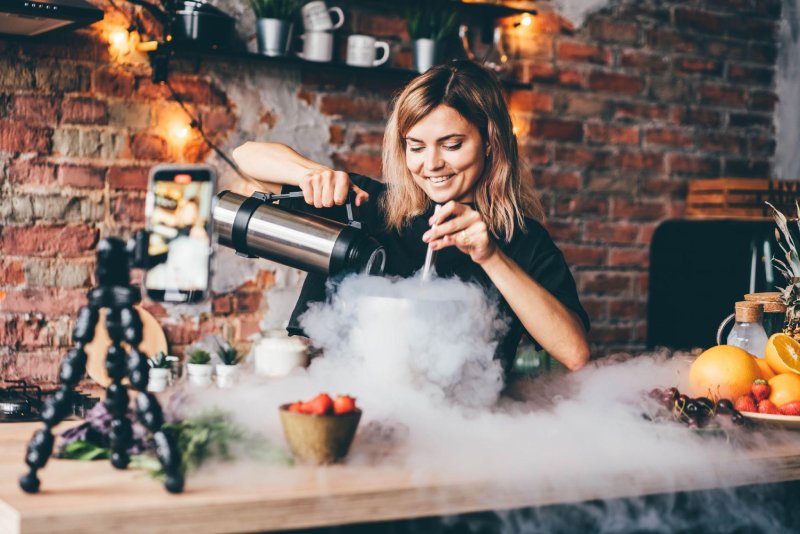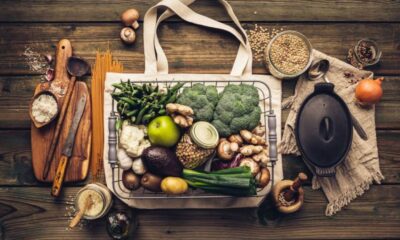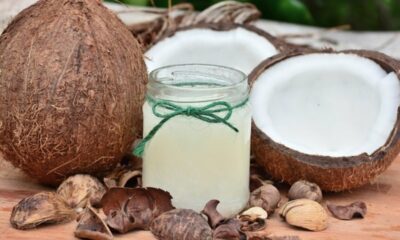Food
Molecular Gastronomy at Home: Matt Sommers Explores Modern Cooking Techniques for Foodies

Molecular gastronomy is a captivating discipline that has grown popular with food lovers. It combines science, art, and cooking for inventive, thrilling dishes that challenge classic cooking. With technology and materials, it’s for more than just chefs or fancy restaurants. Home cooks can explore, too!
This modern technique offers many ways to be creative. These techniques bring surprise and joy to the dinner table, from spherification to emulsification. Home cooks can make ordinary items into extraordinary meals with liquid nitrogen or agar agar. Matt Sommers shares insights into the fascinating world of molecular gastronomy, making it accessible to home chefs.
This method demands precision and exploration. Meticulously measure and combine elements for desired effects. It may seem daunting, but practice and patience make anyone an expert. The joy comes from discovering new possibilities.
What is Molecular Gastronomy?
The approach brings science and cuisine together in a one-of-a-kind way. Exploring and manipulating ingredients to develop groundbreaking foods that wow the world. This trend of modern meal preparation has taken off!
Thrilling foodies offer unique techniques to get creative in the kitchen. For a whimsical twist, try spherification to turn liquids into flavor-filled bubbles—or foam creation. Aroma extraction allows chefs to capture fragrances for a multisensory journey.
But it doesn’t stop there. Unconventional items like liquid nitrogen and xanthan gum challenge traditional methods. They are creating unusual consistencies and flavors that tantalize the taste buds.
Benefits of Molecular Gastronomy at Home
Culinary science at home brings a range of unique benefits for food enthusiasts. These benefits include:
- Exploring New Culinary Techniques: It allows individuals to explore innovative meal preparation methods like spherification, foams, and gels. These techniques enable home cooks to transform materials into intriguing and visually appealing textures, taking their dishes to new levels.
- Creating Visually Stunning Meals: Through this method, home cooks can prepare visually striking presentations with unique shapes, textures, and colors. The artistic aspect brings excitement and aesthetic pleasure to the dining experience.
- Enhancing Flavor Profiles: Culinary alchemy approaches, such as using liquid nitrogen or a smoking gun, can unlock new dimensions of flavors and aromas. These methods can intensify or modify taste sensations, providing extraordinary gustatory experiences.
- Experimenting with Ingredients: It encourages culinary experimentation by combining unexpected elements and exploring unconventional flavor pairings. Home cooks can use the freedom to play with textures and flavors to prepare foods that surprise and delight their guests.
In addition to these benefits, it offers a range of innovative tools and items that allow individuals to explore their creativity in the kitchen.
Essential Equipment and Ingredients for Molecular Gastronomy
Having the necessary equipment and elements is crucial to embark on your food journey. The tools and substances needed for culinary exploration vary from traditional methods.
One indispensable item is a precision scale, which allows you to measure materials accurately. It is crucial as it relies on precise measurements to achieve optimal results. Another essential piece of equipment is a sous vide machine, which ensures precise temperature control during food preparation. Additionally, you will need tools such as syringes, pipettes, and silicone molds to create unique textures and shapes.
Molecular Gastronomy Kits
Specific kits are must-haves for exploring modern cuisine. They provide a range of special tools and elements to help chefs and food enthusiasts take culinary practices to the next level.
Spherification is one of the approaches these kits make possible. This involves turning liquids into spheres with flavor-filled bursts. For instance, you could create balsamic pearls or fruit juice capsules with the right components – sodium alginate and calcium chloride.
Foaming is another fun option. With soy lecithin, you can transform any liquid into an airy foam to add texture and flavor to the item. The possibilities are endless, from lemon foam to top your seafood dish to chocolate foam on your dessert.
It also offers flavor-enhancing methods like the sous vide method. It involves vacuum-sealing food and making it in a temperature-controlled water bath. It ensures tender meats and boosted flavors.
Liquid Nitrogen
Liquid nitrogen has a boiling point of -320°F (-196°C) and is used worldwide by chefs. It creates an impressive show and provides unique textures. This key ingredient makes the experience captivating.
It can quickly freeze and transform ingredients. Chefs use it to make airy foams and desserts that have unexpected flavors. Also, it creates incredible tableside experiences, like cocktails that emit billowing clouds when combined with liquid nitrogen.
Safety is most significant while using liquid nitrogen. Wear protective clothing and gloves to avoid frostbite. Make sure to work in well-ventilated areas to avoid hazardous gas buildup. Do not compromise safety for culinary innovation.
Hydrocolloids and Gelling Agents
Hydrocolloids and gelling agents are a must in culinary alchemy! These items give dishes unique textures. Chefs can make creative and sophisticated meals using them.
Agar agar is a popular hydrocolloid. It’s made from seaweed and sets custards, jellies, and foams. It’s great for experimenting with textures and presentations.
Gelatin is another vital gelling agent. Made from animal collagen, it works in traditional and food science. It makes dishes like panna cotta and mousses smooth and delicious. Gelatin’s ability to create stable gels under different conditions makes it indispensable.
Xanthan gum is also essential in this method. It thickens sauces and emulsifies liquids without changing flavors. Chefs can use it to create smooth textures.
When using these ingredients, follow precise measurements and procedures. Slight variations can drastically affect the result. Experiment and adjust until you get the desired texture and consistency.
Popular Modern Cooking Techniques
Modern cooking techniques have become increasingly popular among food enthusiasts and home cooks. These innovative methods enhance the flavors and textures of dishes and allow for creative presentations.
Spherification
Spherification creates flavorful liquid droplets with thin skin on the outside and a liquid core inside. When eaten, these pearls burst and release their flavor. Chefs can experiment using different flavors, shapes, and sizes to create unique creations.
Foams and Emulsions
Chefs take ordinary liquids and transform them into airy foams using specialized equipment. Infusing nitrogen or carbon dioxide creates delicate bubbles that burst into flavor. Emulsions mix oil and water-based items, making velvety sauces and dressings.
These techniques appear in different cuisines around the world. Foams may be found in soups or as dessert garnishes. Emulsions are used in mayonnaise and hollandaise sauce.
Today, chefs use foams and emulsions to innovate. With endless flavor and texture possibilities, these systems remain at the forefront of modern meal preparation.
Sous Vide Cooking
Sous vide is popular. It involves vacuum-sealing food in a bag and preparing it in a precise water bath. This method ensures food is evenly prepared and retains the natural flavors and textures.
Advantages of sous vide:
- The precise temperature control ensures consistent results.
- Preparing items at lower temperatures for longer preserves tenderness.
- Adding herbs, spices, and marinades adds flavor.
- Easily prepare meals in advance and store them.
Step-by-Step Instructions for Molecular Gastronomy Recipes
Achieving mastery of modernist cuisine requires following a precise set of instructions to create innovative and avant-garde dishes. This guide provides a step-by-step approach to mastering the art of food science and explores cutting-edge cooking for food enthusiasts.
- Preparation: Begin by gathering all necessary ingredients, tools, and equipment. Ensure you have access to specialized ingredients like liquid nitrogen, agar-agar, and sodium alginate. Familiarize yourself with the specific measurements and ratios needed for each recipe.
- Techniques: Explore the world of modern cooking by learning methods such as spherification, emulsification, foams, and gels. Follow the detailed instructions to create unique textures and flavors characteristic of modernist cuisine. Experiment using different combinations of ingredients to unlock novel taste experiences.
- Presentation: Elevate your dishes by paying particular attention to the exhibition. Use artistic plating, garnishes, and edible decorations to create visually stunning and unforgettable culinary creations. Consider adding an element of surprise by incorporating this approach into traditional dishes.
Through careful preparation, mastery of cutting-edge methods, and attention to presentation, you can create visually stunning and gastronomically memorable dishes that will leave your guests in awe.
-

 Sports4 weeks ago
Sports4 weeks agoFIFA Club World Cup 2025: Complete List of Qualified Teams and Groups
-

 Sports2 weeks ago
Sports2 weeks agoAl Ahly vs Inter Miami, 2025 FIFA Club World Cup – Preview, Prediction, Predicted Lineups and How to Watch
-
Health1 week ago
Back to Roots: Ayurveda Offers Natural Cure for Common Hair Woes
-
World4 weeks ago
Omar Benjelloun: Strategic Architect Behind Major Financial Deals in the MENA Region
-

 Sports3 weeks ago
Sports3 weeks agoFIVB Men’s Volleyball Nations League 2025: Full Schedule, Fixtures, Format, Teams, Pools and How to Watch
-

 Tech1 week ago
Tech1 week agoFrom Soil to Silicon: The Rise of Agriculture AI and Drone Innovations in 2025
-

 Startup2 weeks ago
Startup2 weeks agoHow Instagram Is Driving Global Social Media Marketing Trends
-

 Science4 weeks ago
Science4 weeks agoEverything You Need to Know about Skywatching in June 2025: Full Moon, New Moon, Arietid Meteors, and Planetary Marvels

















